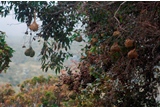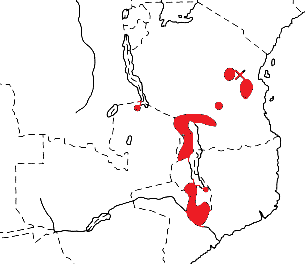Weaver species
Choose different species from drop-down list and press 'Go' button. See Full species list.Bertram's Weaver Ploceus bertrandi
IUCN: Least concern Discovery: 093Categories: acacias, nectar, palm,
News items about species
Discovery
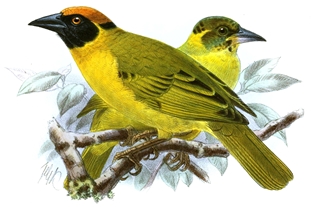
figure from Shelley (1893) 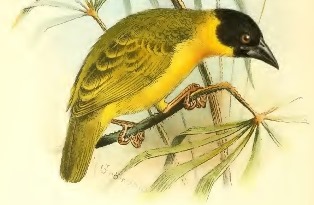
figure from Shelley (1905) 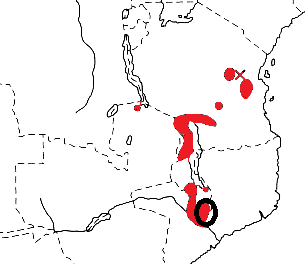
distribution, type locality circled IntroductionBertram's Weaver was formally described by George Ernest Shelley, an English geologist and ornithologist.Bertram's Weaver was collected by Alexander Whyte, a Scottish botanist. Commissioner HH Johnston hired Alexander Whyte to collect fauna and flora specimens in British Central Africa. Bertram Lutley Sclater, the son of the ornithologist Dr. P. L. Sclater, and Commander of the Police Force of British Central Africa 1891-93, accompanied the expedition as security. Whyte collected birds in 3 localities in southern Malawi in 1891. On 29 May they ascended Mt Zomba, then collected specimens here during Aug-Sep, including two Bertram's Weaver specimens. On 20 Oct the expedition visited Mt Milanji spending 2 weeks on the plateau, collecting one Bertram's Weaver specimen. Whyte also collected several female Bertram's Weaver specimens in southern Malawi during 1892. These were also investigated by Shelley (in 1894) who described them as males of a separate species. A few decades later, Neunzig 1924a realised that these were the female of Bertram's Weaver, based on a large sample of specimens of both taxa in the Berlin Museum. Shelley named Bertram's Weaver after Bertram Lutley Sclater, but the scientific name was given as bertrandi rather than as bertrami. The first illustration of Bertram's Weaver was of a male and juvenile, published by Shelley (1893) in his initial description of the species. The next illustration was of the female of this species in Shelley (1905), initially thought to be the male of a different species. Scientific citationHyphantornis bertrandi Shelley 1893a, Ibis, p.23, pl. 2, Plains near Milanji, southern Nyasaland [Zomba].Meaning of namesbertrandi, Named after Captain Bertrand L. Sclater (1866-1897).First English nameNyasa Black-beaded Weaver (Shelley 1905b).Alternate namesBertrand's Weaver, Bertrand's Masked-Weaver, Nyasa Black-beaded Weaver.CollectorAlexander Whyte.Date collectedAug, Sep, Oct 1891.Locality collectedMilanji (Mount Mulanje) and Zomba, Malawi.Type specimensThree syntypes are in the British Museum (eg BM 1892.9.10.181). |
The above is based on Weaver Wednesday 2, a weekly series about the discovery of each weaver species.
This species text first appeared as
Weaver Wednesday [210] - Discovery [93]: Bertram's Weaver on 2016-06-22
1. Basic biology
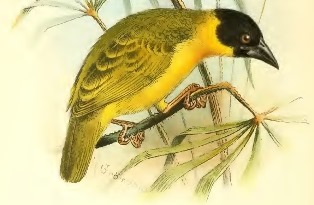
figure from Shelley 1905 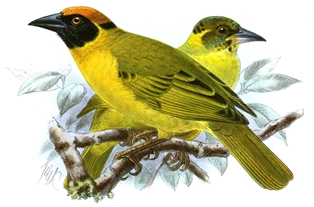
figure from Shelley 1893 Distribution. Bertram's Weaver occurs in eastern Africa, from Tanzania, through Zambia and Malawi to Mozambique (see map below, based on Birds of Africa). No subspecies are recognised.
Habitat. Bertram's Weaver inhabits open woodland and bush along rivers, forest edges and cultivation in hilly country. It is found in trees and bracken-briar along stream lines in Zambia. Food. Bertram's Weaver feeds on insects and nectar. It forages in pairs and in small groups of five or six individuals, by gleaning insects from vegetation. Breeding. Bertram's Weaver is a monogamous, solitary nester. The nest is a ball woven of broad grass strips, without an entrance tunnel. The nest resembles the nest of the Holub's Golden Weaver, but is rounder. The nest is lined with grass seed heads. It is typically placed near the tip of a lower branch of camelthorn acacias, or in the leafy end of an evergreen tree branch, and often near a stream. The eggs (clutch size 2) are deep green, heavily blotched and spotted with red-brown. The young fed by both sexes. |
The above is based on Weaver Wednesday, a weekly series about weaver species.
This species text first appeared as
Weaver Wednesday [80]: Bertram's Weaver on 2013-12-25
2. Breeding facts
| Pair bond Monogamous Breeding season Apr in Tanzania, Nov-Dec in Zambia and Aug-Apr (also record of fledged young fed by adults in May) in Malawi Nest site usually placed at tip of branch of thorny acacia (Acacia) or in evergreen tree, often near a stream Nest building no information Colony size Solitary nester Clutch size 2 eggs Egg colour deep green, heavily marked with red-brown spots and blotches Egg size size 22.5 x 16 mm (Malawi) Incubation no information Chicks and nestling period young fed by both sexes |
Breeding information based on Handbook of the Birds of the World, Vol. 15.
3. Photos of Weaver Nests
 Vm 30690 |
Thumb-nails of most recent PHOWN records - click on one to see its full record
See all PHOWN records for this species here.
PHOWN (Photos of Weaver Nests) provides valuable info on breeding distribution and colony sizes of weavers.
You can contribute by registering and submitting photos at Virtual Museum webpage.
4. Breeding distribution
Google map showing distribution (For species with small ranges you need to zoom in at the correct area to see the range):
yellow blob - range of weaver species; read more about this here.
![]() - PHOWN records with photos
- PHOWN records with photos
![]() - PHOWN records with no photos (Nest Record Cards, other records)
- PHOWN records with no photos (Nest Record Cards, other records)
![]() - Birdpix records
- Birdpix records
![]() - comments on out of range records, or interesting records
- comments on out of range records, or interesting records
![]() - type locality
- type locality
CLICK on the marker on the map to see individual record details.
5. Range changes
Not South African speciesThe above is based on Weaver Wednesday 3, a weekly series about range changes in South African weaver species.
This species text first appeared as
n/a








